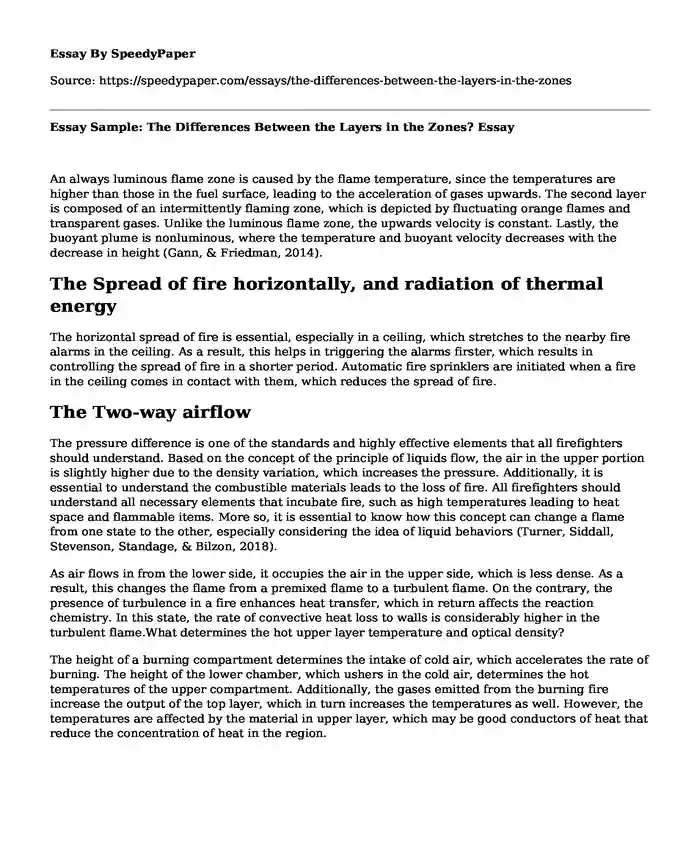
| Type of paper: | Essay |
| Categories: | Knowledge Engineering Physics |
| Pages: | 4 |
| Wordcount: | 828 words |
An always luminous flame zone is caused by the flame temperature, since the temperatures are higher than those in the fuel surface, leading to the acceleration of gases upwards. The second layer is composed of an intermittently flaming zone, which is depicted by fluctuating orange flames and transparent gases. Unlike the luminous flame zone, the upwards velocity is constant. Lastly, the buoyant plume is nonluminous, where the temperature and buoyant velocity decreases with the decrease in height (Gann, & Friedman, 2014).
The Spread of fire horizontally, and radiation of thermal energy
The horizontal spread of fire is essential, especially in a ceiling, which stretches to the nearby fire alarms in the ceiling. As a result, this helps in triggering the alarms firster, which results in controlling the spread of fire in a shorter period. Automatic fire sprinklers are initiated when a fire in the ceiling comes in contact with them, which reduces the spread of fire.
The Two-way airflow
The pressure difference is one of the standards and highly effective elements that all firefighters should understand. Based on the concept of the principle of liquids flow, the air in the upper portion is slightly higher due to the density variation, which increases the pressure. Additionally, it is essential to understand the combustible materials leads to the loss of fire. All firefighters should understand all necessary elements that incubate fire, such as high temperatures leading to heat space and flammable items. More so, it is essential to know how this concept can change a flame from one state to the other, especially considering the idea of liquid behaviors (Turner, Siddall, Stevenson, Standage, & Bilzon, 2018).
As air flows in from the lower side, it occupies the air in the upper side, which is less dense. As a result, this changes the flame from a premixed flame to a turbulent flame. On the contrary, the presence of turbulence in a fire enhances heat transfer, which in return affects the reaction chemistry. In this state, the rate of convective heat loss to walls is considerably higher in the turbulent flame.What determines the hot upper layer temperature and optical density?
The height of a burning compartment determines the intake of cold air, which accelerates the rate of burning. The height of the lower chamber, which ushers in the cold air, determines the hot temperatures of the upper compartment. Additionally, the gases emitted from the burning fire increase the output of the top layer, which in turn increases the temperatures as well. However, the temperatures are affected by the material in upper layer, which may be good conductors of heat that reduce the concentration of heat in the region.
What is the neutral plane?
A neutral plane is defined as the shift in a gradient of the cold air intake, as compared to the emission of the hot air from a burning element (Filkov, Duff, & Penman, 2018). The change in gradient increases the amount of fire, as cold air with a higher density is sucked in to increase the amount of fire, while the amount of hot air gradually rises on the other hand.
The neutral plane is attained once, the airflow in a burning object is intercepted, as the gradient of these two elements is brought into a normal state. Additionally, the reduction in a neutral plane, means there is minimal cold air intake, which reduces the amount of fire.
The Essence of understanding the neutral plane
The neutral plane defines the amount of fire in a burning building. In a search and rescue mission, it is essential to understand the root cause of a fire. Air contains 21% of oxygen, which is a critical element that fuels fire (Qiao, Shao, Wei, & Zhang, 2019). However, in a scenario where the inflow of cold air is not regulated, burning increases consuming the entire building. As a result, it is essential to understand this concept, as the interception of cold air will reduce the rate of fire, hence making it possible for a search and rescue mission. On the contrary, it is essential to understand the concept in this case, to help understand the increase in hot air output, despite the inlet consuming little air. The produced gases cause the increased outlet air in the fire, which increases the amount of heat and smoke in the compartment, hence limiting visibility.
References
Filkov, A. I., Duff, T. J., & Penman, T. D. (2018, September). Extreme fire behaviors: Surveying fire management staff to determine behavior frequencies and importance. In Bushfire and Natural Hazards CRC & AFAC conference (pp. 5-8).
Gann, R., & Friedman, R. (2014). Principles of fire behavior and combustion. Jones & Bartlett Publishers.
Qiao, R., Shao, Z., Wei, W., & Zhang, Y. (2019). Theoretical investigation into the thermo-mechanical behaviours of tunnel lining during RABT fire development. Arabian Journal for Science and Engineering, 44(5), 4807-4818.
Turner, P. J., Siddall, A. G., Stevenson, R. D., Standage, M., & Bilzon, J. L. (2018). Lifestyle behaviors and perceived well-being in different fire service roles. Occupational medicine, 68(8), 537-543.
Cite this page
Essay Sample: The Differences Between the Layers in the Zones?. (2023, Mar 21). Retrieved from https://speedypaper.com/essays/the-differences-between-the-layers-in-the-zones
Request Removal
If you are the original author of this essay and no longer wish to have it published on the SpeedyPaper website, please click below to request its removal:
- Free Essay Sample on Freedom to Children
- Beowulf and the Monsters - Literary Essay Sample
- Essay Example. Interaction Between Gifted Students and Teachers
- The Need to Reform the Texas Death Penalty - Essay Sample
- Free Essay on Swot Analysis of Hilton Los Angeles Airport Hotel
- Mathematics Class Discussion - Free Essay Example
- Ways in which Teachers can Embrace diversity in the United States - Paper Example
Popular categories




